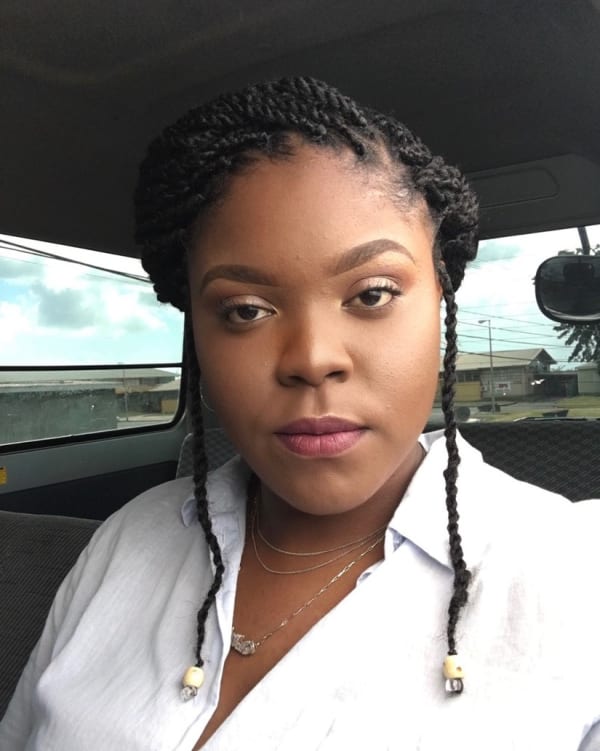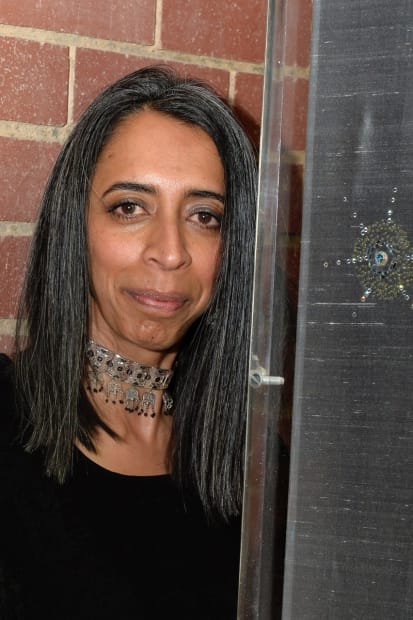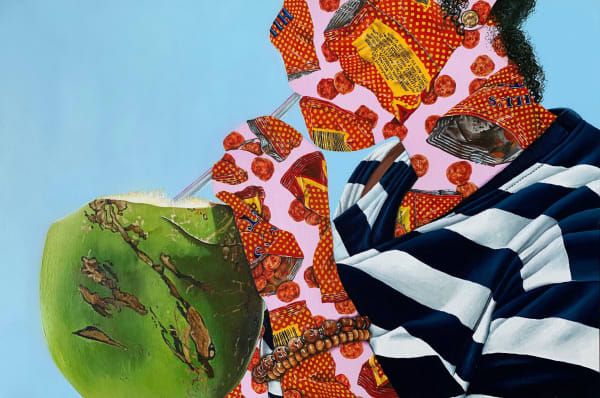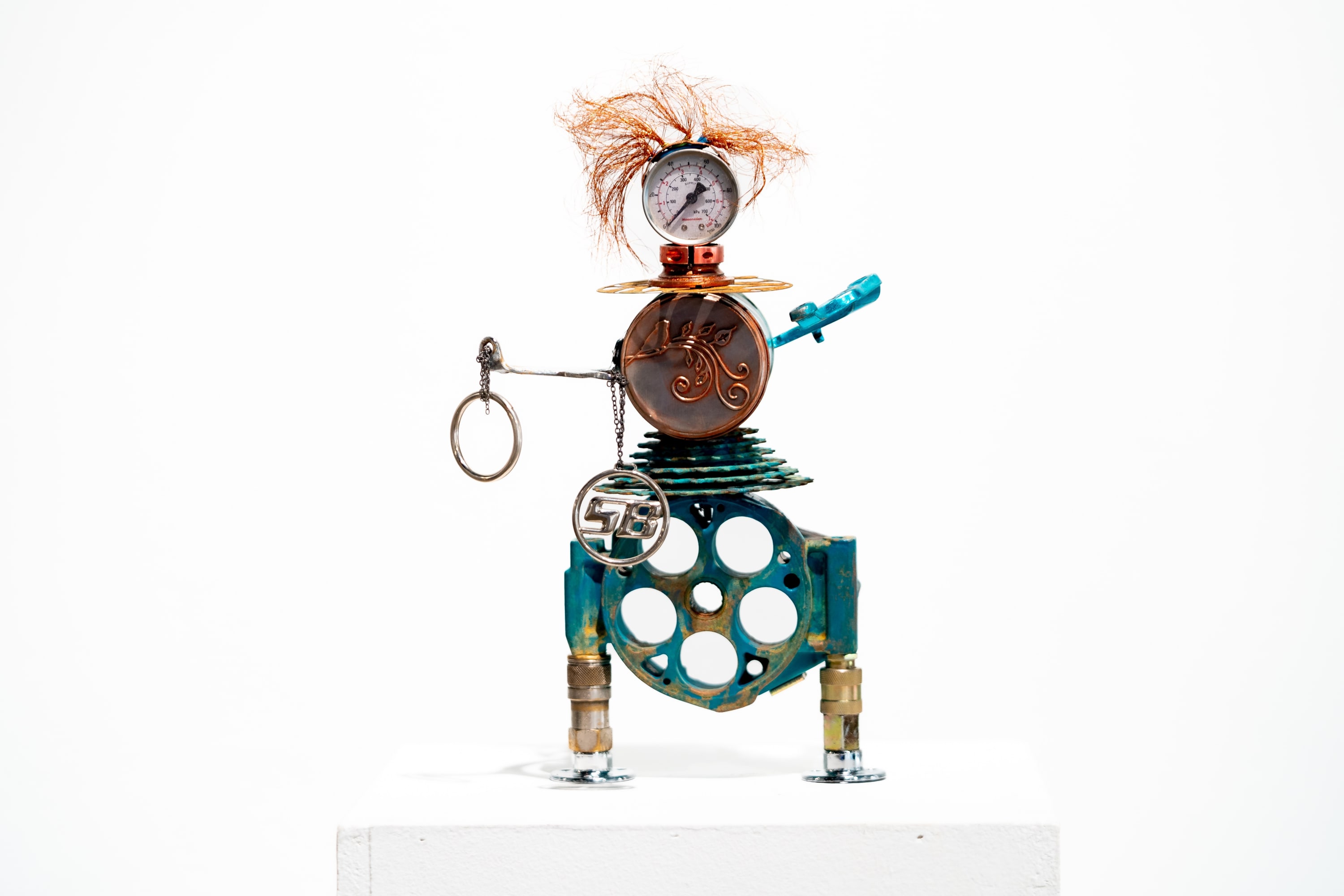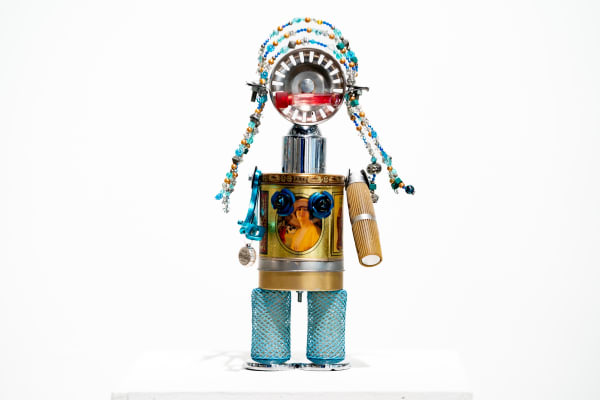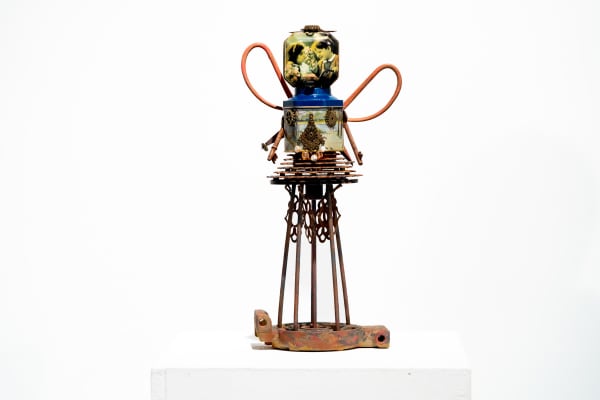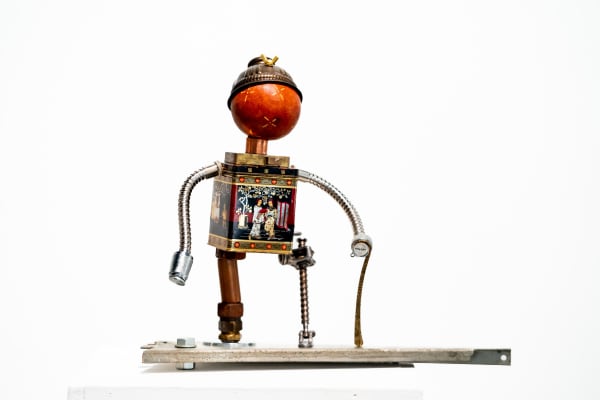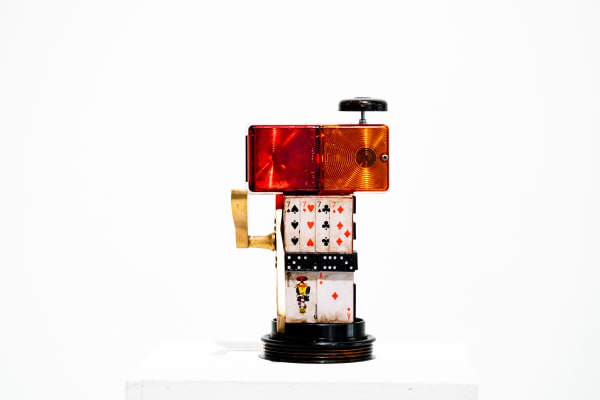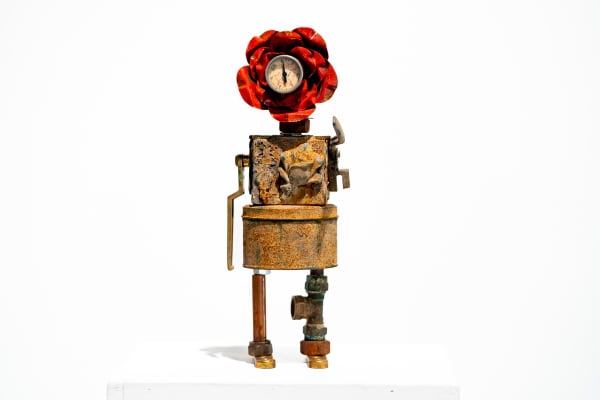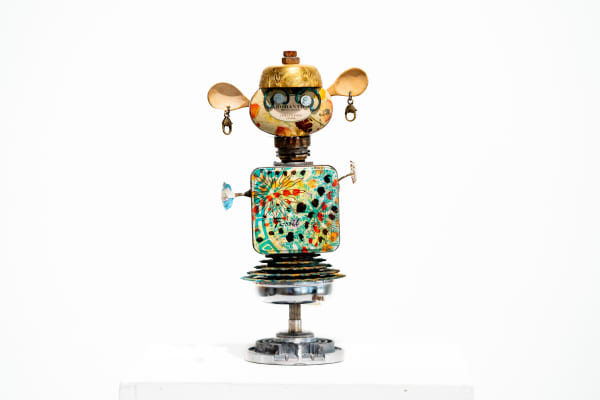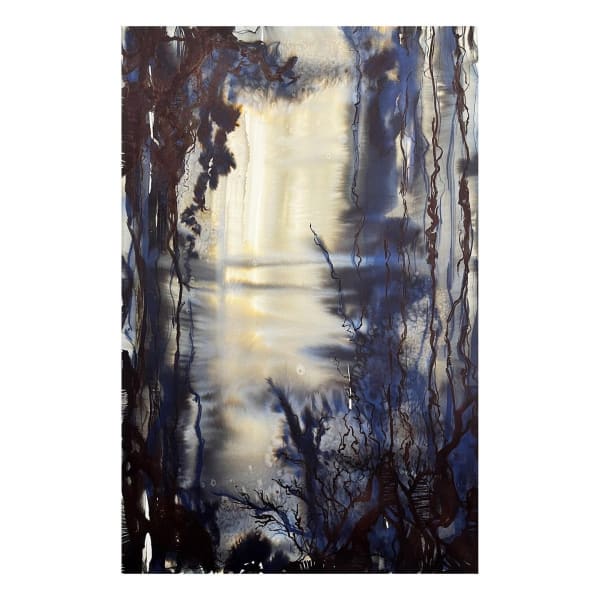-

-
Participating artists
-

Akilah Watts
Barbados, Caribbean. B: 1996.Watts is a contemporary artist who received her BFA in 2017 and participated in the Prizm Art Fair that same year. She works with various mediums and has appeared both in Barbados and internationally (New York, San Francisco, Miami, etc). Her first solo show launched in March 2019 at the World Trade Centre in New York City in 2021. Online, she has appeared in exhibitions, auctions, articles (Easy magazine, M People, Art LeadHER, and Artnet) and shops, including Artsy, Les Iles and Good Black Art. She focuses on her relationship with her natural hair and her Caribbean roots. Her body of work entitled “Moments from My Island Home” is her way of bridging the gap between the realistic and the idealistic view of her island, Barbados.
-

Amita Makan
Gqeberha, South Africa. B:1979 -2023Celebrated internationally for fabric constructions with embroidery and collage, Amita Makan infuses her work with identity, memory, and history by using vintage saris while incorporating contemporary influence with found materials, like plastic litter. She has produced four solo exhibitions: Āvāhana- Invocation (Oliewenhuis Museum, Bloemfontein, 2021), Vasant (Galerie Rosa Turetsky, Geneva, 2016), Nomalungelo: Threads To Freedom (Constitution Hill, Johannesburg, 2014), and Evanescence (KZNSA, Durban, 2011). She has appeared in various group exhibitions both locally and internationally, such as Fynarts Festival (Hermanus 2022) and Imago Mundi – Bennetton Foundation (Treviso, Rome, Venice Biennale, Pratt Institute of Brooklyn and the United Nations, New York, 2015). She has been awarded residencies in Paris and Hyderabad with works housed in numerous exhibits around the world.
-

Andrea du Plessis
Cape Town, South Africa. B: 1980A multi-disciplinary artist specialising primarily in fields of traditional painting and new media, du Plessis studied Fine Arts at the University of Pretoria, a postgraduate diploma in Art Therapy in the UK, as well as a degree in Multimedia Digital Visual Arts (UNISA Cum Laude). As winner of the Sasol New Signatures award, she showcased her first solo exhibition in 2022 at the Pretoria Art Museum. Her work explores humanity’s complex relationship with both nature and technology.She experiments with emerging technologies such as augmented reality, algorithmic art, image and sound generated by artificial intelligence, as well as virtual reality. She revisits antiquity through painting techniques used by the old masters while exploring contemporary technological inclusions. The result is a tension-filled interface that transports the viewer into a familiar yet alien world
-

Bercia Roos
Johannesburg, South Africa. B: 1961Bercia Roos is a local artist who finds beauty and purpose in detritus and discarded items. Her career began as an interior decorator and fashion designer, and she continued creating three-dimensional art from discarded and pre-loved materials after completing her first recycled art figurine as a birthday gift for a special friend. From this artistic interpersonal connection, she discovered a world of debris at her fingertips. Roos explores rebirth and connections to the past through the repurposing of junk and scrap from various sources, from found objects in the world around her to her husband's workshop and Johannesburg's salvage yards. Through her creative vision, she channels the ethos that one person’s trash could be another’s treasure.
-

Francois Knoetze
Cape Town, South Africa. B: 1989A visual artist working in video, performance, sculpture and new media, Knoetze holds a BA in Fine Arts from Rhodes University and an MFA from Michaelis School of Fine Art at UCT. His work retraces the life cycles of discarded objects and explores junctures between material and social histories. In his sculptural suits, the synthetic is welded to the human. His multifaceted approach has focused on investigating technopolitics and relationships between production, consumption and waste. His work explores these objects within social and political contexts and has been exhibited at the Dakar Biennale, Centre Pompidou, ZKM Center for Art and Media, Lubumbashi Biennale, The Guggenheim and the Akademie der Künste. Fellowships and awards include Digital Earth Fellowship (2019), Mail and Guardian’s Top 100 Young South Africans (2017), and Mozilla Foundation’s Creative Media Award (2022).
-

Mbali Tshabalala
Johannesburg, South Africa. B: 1988Mbali Tshabalala (1988) is a Johannesburg based artist and curator who has recently relocated from Cape Town after spending two year as assistant curator at the Zeitz Museum of Contemporary Art Africa (Zeitz MOCAA). She’s currently completing a Bachelors Degree in Fine and Applied Art from the Tshwane University of Technology. Mbali studied printmaking at the Art Proof Studio and has a background in Graphic Design. She is also the founder of the Collective UNTITLD and has been working as a curator in Pretoria, Cape Town and Johannesburg for the last six years
-

Nyakallo Maleke
Johannesburg, South Africa. B: 1993.Nyakallo Maleke is a local artist and writer, based in Johannesburg. Her creative practice is grounded in an expanded concept of drawing, which she views as a means to tell stories about space, movement, and walking. Maleke's drawings and artworks take shape through various media, techniques, and disciplines, manifesting as installations, performances, sound pieces, prints, or sculptures. Her most recent works are invested with materiality, often combining traditional drawing media with meticulous embroidery like stitching and unconventional materials such as wax paper. In 2015, she completed her Bachelor’s degree in Fine Arts from Wits University and has participated in a variety of group exhibitions at venues including Aichi Triennale in Japan as well as the Modzi Arts Gallery in Zambia.
-

Nindya Bucktowar
Mauritius and South Africa. B: 1988A multi-disciplinary artist who experiments with clay and multiple mediums to create installations inspired by natural and urban landscapes, Bucktowar specialises in ceramic topographical sculptures and installations. She graduated with a Bachelor in Architectural Studies at Nelson Mandela University in 2013 and currently lectures while running her own design practice and ceramic business (Nindya Ceramics and co-director of NT Design Studio, NT Leather and Kalki Ceramics). She was selected for the RMB Talent Unlocked programme in association with Everard Read and Strauss & Co, after which her work was acquired by FirstRand art collection. She has appeared in several group exhibitions and collaborative projects, and held her first solo exhibition at the KZNSA Gallery in 2021. Most recently, she won the Nando’s Hot Young Designer competition, led by Clout SA.
-

Pardon Mapondera
Chitungwiza, Zimbabwe. B: 1992Mapondera’s tumultuous education (as a result of his country’s economical and political frustrations) led him to apply at the National Gallery Visual Art and Design. He was advised to pursue this avenue, since art is his passion and he wanted to enrich his knowledge. In 2011, his application was not successful. He then went to the countryside to work in farming as well as work towards building another portfolio to use for his next application. With his keenness and tenacity, he received the guidance needed to curate another strong portfolio from his brother who is a prominent visual artist (Wallen Mapondera). Finally, he enrolled in his dream school in 2015 and graduated in 2016. He now works as a full-time artist from Chitungwiza, near Harare
-

Shalom Kufakwatenzi
Harare, Zimbabwe. B:1995Kufakwatenzi works with self-expression, telling people’s stories and recording what she sees and experiences in her day-to-day life. She works with different mediums, allowing them to bring out the best of herself through installations, performance art and photography and a few inspirations such as music, poetry, dance and fashion. Her work is mostly feminine, touching on gender, religion, social structures, politics and the impacts of these elements on us as a people. Through these areas, Kufakwatenzi feels able to express herself and speak up on pressing matters, providing a voice for the voiceless and advocating for those most often left by the wayside without the platforms to express on a larger scale. She seeks to be an inspiration to others and, importantly, also to herself.
-

Takudzwa Leeroy Guzha
Chitungwiza, Zimbabwe. B: 1995Art proved to be a passion for Guzha in school, which led him to focus on art as a career and continued his art education at the National Gallery School of Visual Art and Design from 2013 to 2016. He successfully completed his studies with a certificate of competence. The artist has participated in several exhibitions in Zimbabwe and South Africa since 2013. He describes the process of his practice as infinite as he feels mediums can be manipulated in so many different ways to build images. Inspired by Batik, he says that circles are a prominent visual element in his work, in both paintings and sculptures. Guzha believes that everything in life exists as a circle – even life itself, and things keep repeating themselves in different ways.
-

Regi Bardavid
Egyption/South African B. 1945Bardavid was born in Alexandria Egypt and has travelled extensively, living in Italy, Zimbabwe, Zaire and South Africa. She has remained firmly rooted in the ‘abstract’ throughout her career which spans more than four decades. Bardavid studied under the guidance of the artist, teacher and activist Bill Ainslie at the Johannesburg Art Foundation (1979-1983). Completed her Matric in 1984 and enrolled as a Fine Art student at UNISA in 1985 achieving a B.A.F.A. in 1989. The inspiration and passion that she manifests in her work demonstrates the sincerity in her conviction, which offers the work integrity and justifies the critical and commercial successes it has garnered through the years which made her the highlight artist in 2016 at the 1:54 Contemporary Art Fair in London.
-
-
To embrace the shadow is the journey of the sun and the soul
Curatorial statement by Ruzy RusikeThese artists, like nature herself does, allow for the process of life, death and rebirth. This opens the conversation of poverty, reification, racial injustice, and the fight for climate justice.
Despite our familiarity with the notion of ‘ashes to ashes and dust to dust’, our distance from our environment has never been greater. The distance between us and the ground is immediately captured in our embrace of the concept, it is an embrace laced with madness where our cravings have pulled us away from our natural home and driven us to urban complexes.We are rendered imbalanced, incapable of dialogue with the natural world. We must recapture our origins, when we were embedded in a reciprocal relationship with nature. Indigenous knowledge systems and traditional healers know this intrinsically, but most of us have forgotten the way.Eco-psychologist, Theodore Roszak, writes: “In four centuries of taking wealth and comfort from the body of the Earth, modern science has not troubled to produce a single rite or ritual, not even a minor prayer that asks pardon or gives thanks. ”Therefore, the human being exists in alienation from nature, making it a moral, political, and ethical quandary of our time.Anthropocene is a geological epoch that encapsulates the commencement of tangible human impact on Earth’s ecosystems. It is a euphemistic term (“anthropo” referring to “humans” and “cene” meaning “new”) that fails to condemn humanity as the cause of mass extinction of plants and animals alike, the pollution of our oceans, the swathes of deforestation, the alteration of our very atmosphere, and countless other lasting impacts. Therefore, when we present the environmental crisis of our time, what is it that we are calling people to recognise? Thus far, the environmental crisis has been narrated to us by scientific, technical, political, and economic conversations that analyse and atomise the issues and problems through these lenses. However, a shortcoming is the oversight of our connectedness.All such forms of isolation are artificial because that which is isolated needs to be reconstituted as you can only artificially remove anything from the natural world and the greater system - Roszak. The philosophy of Ubuntu found in the Bantu languages of East, Central and Southern Africa transcends this individualism, the ethos of choice in the Western world.Ubuntu’s ethical message is not restricted to one’s own ethnic group, regional community, or nation, but covers all of humanity, our ancestors, and the realms beyond our present understanding. It is the standpoint that a person is a person through other people. “I am what I am because of what we all are.” We affirm our humanity when we acknowledge that no single individual is complete without another.These interpersonal relationships are integral to our understanding of moral behaviour and communal living in our world. We must return to this understanding before we embrace a corrupted state of ecological unconsciousness, where our shadow becomes separate from our experience of the sun and our soul.This exhibition does not seek to interpret ‘sustainability’ in its most reductive sense – climate change and renewable resources. Instead, the artists curated here respond to the intimacy of what it means to create an environment for human life and generational well-being, forming part of the process of nature that eliminates the ego, which puts us at the centre of the ecosystem.These artists, like nature herself does, allow for the process of life, death and rebirth. This opens the conversation of poverty, reification, racial injustice, and the fight for climate justice.The core issues at play sit beyond our reach, deep within our unconscious minds and thus the sensual aspects of living within the world are ignored. The only manifesting symptom capable of surfacing from deep within our minds is profound grief. This grief is prevented from expressing itself despite the fact that it knows – we know – that our land is dying.This is the root of this exhibition. In it, we face the shadow and acknowledge that the consciousness of our being demands courage, determination and choice. We must integrate what is seen and known with what is unseen and unknown. In this interconnected spiral of reality and spirit, we take a journey of sun and soul. Without the light, the conscious self will be a slave to the shadow.In this journey, our spirit connects to the world and we may find that we can tap into our unconscious mind and the ecological wisdom it carries.Maybe then, we can save ourselves.Maybe then, we can save the world. -
The Exhibition
-
In remembrance of Amita Makan
-

-
AKILAH WATTS
ARTIST STATEMENT
I am intrested in depecting a black Barbadian experiencce. My work focuses a lot on my own personal experience as a black Barbadian artist but I also touch on more general Caribbean experiences in some of my works. My main goal is to instill a feeling of nostalgia and or curiosity in the people who view my work. I want the viewer to be entranced in a style of Caribbean art that feels familiar but still relatable.
-
 Akilah WattsNexus, 2021Acrylic on canvas152 x 122 x 2.5 cm$ 11,500.00
Akilah WattsNexus, 2021Acrylic on canvas152 x 122 x 2.5 cm$ 11,500.00 -
Bercia Roos
Artist Statement
Roos explores rebirth and connections to the past through the repurposing of junk and scrap from various sources, from found objects in the world around her to her husband's workshop and Johannesburg's salvage yards. Through her creative vision, she channels the ethos that one person’s trash could be another’s treasure.
-
-
-
Francois Knoetze
-
Francois KnoetzeVideo Home System Suit, 2022Mixed media sculpture (VHS tapes)190 x 92 x 44 cm(C006884)R 69,000.00 (inc tax)*Mongo n. slang. object thrown away and then recoveredCape Mongo follows the stories of six characters as they journey through the city of CapeTown. Each Mongo character is made from the city’s discarded waste–mythical ‘trashcreatures’ which have emerged from the growing dumps of consumer culture. In sixshortfilms, the creatures revisit the spaces of their imagined pasts–the locations associated withtheir material existence and the constitution of their social relations–as if walking againstthe consumer-driven currents of city. From postmodern shopping malls to the bustlingstreets of the Bo Kaap to leafy suburbia and desolate shipping-container yards, thesecharacters’ journeys conjure up imagery that touches on some of the historical trajectoriesthat have lead up to the endemic inequality and social alienation which characterisespresent day Cape Town.Artist Francois Knoetze has constructed six wearable sculptures entirely out of waste.Rather than merely disposable items which are purged from our lives as soon as the garbagetruck disappears around the bend or which lie dormant in an ever-widening layer in thecrust of the earth for future archaeologists to marvel at; Cape Mongo imagines trash objects–specifically, the packaging of domestic consumables and the electronic devices used torecordevery-day life–as mnemonic vestiges of the activities that shaped them. Performingall over the city of Cape Town for a period of two years, Cape Mongo is the documentation ofthese performances but also pulls together found footage relating to variousissues aroundhousing, food security, inequality and racial segregation.
-
Mbali Tshabalala
Artist Statement
My artistic practice is an ongoing interrogation of ideals around mental health in black societies; expressed through cultural and religious beliefs that assert misconception and contribute to uninformed notions and superstitions such as, ‘black people don’t get depressed. or ‘mental illness is a symptom of bewitchment or privilege’.
“I embrace the manifestations of an evolving self,” I seek to liberate myself from the latter.
-
 Mbali TshabalalaA World Within ILinocut, paper lithograph, watercolour and hand printing on archival paper112.5 x 83.5 cmSold
Mbali TshabalalaA World Within ILinocut, paper lithograph, watercolour and hand printing on archival paper112.5 x 83.5 cmSold -
Nindya Bucktowar
Artist Statement
Bucktowar works to highlight relationships between bodies and physical or imaginative ‘space.’ Holding it open, falling through it, emptying it, paying homage to it, moving between disciplines and approaches as if moving through rooms of a house. In this house, there are many rooms. Drawings are important, henna patterns are important — also clay, leather, tiles, buildings, the city, the sea. As an early-career ceramic artist, many of these rooms (excitingly, terrifyingly?) remain open.
-
Often refered to as mud mountains, earthforms are an exploration of monumental moments in nature. Textures and forms are extracted from topographical earth formations, to bring to the viewer a playful sense of scale and a re-examination of one’s relationship with the spaces we occupy.
-
-
Nyakallo Maleke
Artist Statement
Her practice is grounded on an expanded concept of drawing, which she sees as a form of research to tell stories about space, movement and walking. Maleke's drawings take shape across media, techniques and disciplines, and can manifest as installations, performances, sound pieces, prints or sculptures. Her recent works are invested in materiality, often combining traditional drawing media with meticulous embroidery-like stitching and unconventional materials such as wax paper. -
Nyakallo MalekeCode Switching Duologue: To Be Given Back Distorted, 2019/2021Installation (Not for Sale)500 cm(C006893)“...given back distorted”-Code Switching Duologues (2019) -Drawing and mixed media installationSouth African scholar Barbara Boswell asserts the notion that the process of fictional writing by blackwomen writers is the space for reimagining themselves on the space of the blank page. A set of drawings/monologues accompanied in the form of a visualized research is being used as amethodology for understanding how vulnerability, potentially reorganizes, silences and reveals thepersonal, and the public through how it moves and interacts in the public space. Code switching duologueis an attempt at thinking about writing processes such as journaling and fiction as a tool for locating andimagining personal narratives of the body, space and feelings through abstracted mark making. It is a workthat invites the audiences to participate by means of walking with the work through space
-
Pardon Mapondera
Artist Statement
-
 Pardon MaponderaUntitled II, 2022Plastic straws, thread, plastic
Pardon MaponderaUntitled II, 2022Plastic straws, thread, plastic
85 x 42 x 29 cmSold -
Shalom Kufakwatenzi
Artist Statement
This is an installation about Letting out emotions or depressing thoughts or pressing matters. It is usually used in the context when friends have something to tell each other, mostly latest gossip (ndidudunurire/ tell me). This piece is inspired by a sunflower, how it is not perfect as a rose but Unique in its own way. A lot of people are suffering from depression and as a Queer person, I am looking at a Queer point of view. How hard it is to come out to people close to you especially your Family and Friends, especially when you come from a conservative or religious family. It can be hard coming out in an environment where they see you as a taboo or in a country that regards Homosexuality as illegal. The word Dudunura means Undo, in the sense that you should not keep it in but tell someone -
 Shalom KufakwatenziDudunura, 2023Mixed media183 x 50 x 26 cm$ 880.00
Shalom KufakwatenziDudunura, 2023Mixed media183 x 50 x 26 cm$ 880.00 -
Takudzwa Guzha
Artist Statement
A tale of a migrant worker from Nyasaland, promised to be given a wife if he was to work for aZezuru man for five years, herding cattle and ploughing the fields. But when it was time to pay,the Zezuru man and his familykilled the man. Now his spirit is claiming what belonged to him andis causing turmoil in the lives of all family members.
-
 Takudzwa GuzhaAchimwene vakabata kanoMixed media on paper126 x 224 x 2.5 cmSold
Takudzwa GuzhaAchimwene vakabata kanoMixed media on paper126 x 224 x 2.5 cmSold -
Mwoyo WekuberekaSpeaks on how a woman would do anything for their child, despite thecircumstances.NematomboDepicts a man with a pipe (mutoriro/dombo) which is more of a psychedelicsubstance that damages brain cells and causes hallucinations, hence one may become violentand uncaring even to their spouses. This results to a mental health challenge that one may needrehabilitation.
-
Regi Bardavid
Artist Statment
“My inspiration comes from the act of play. Releasing the Self of all obligations and constrictions of upbringing.”Regi Bardavid has remained true to her obsession with abstract paintings for over four decades. She has during this time developed a strong and loyal following for her colourful canvases created from oil paint and beeswax. -
Andrea Du Plessis
Artist Statment
Du Plessis uses her practice as a means of exploring humanity’s complex relationship to bothnature and technology. The Covid-19 pandemic has sparked in her an interest in the sublimeexperience and the interplay between nature, technology and spirituality
Her creative methodology involves extensive experimentation with emerging technologies suchas augmented reality (AR), algorithmic art, image and sound generated by artificial intelligence(AI), as well as virtual reality (VR). She revisits antiquity through her use of traditional oil paintingtechniques used by the old masters, such as glazing and the golden ratio, while exploring waysof integrating traditional media with modern technologies. By juxtaposing the 19thcenturyRomantic tradition of painting with contemporary, emerging technologies she aims to create atension-filled interface, momentarily transporting the viewer into a familiar yet alien world, whileoffering an opportunity to reflect on their connection with nature.
-
 Andrea du PlessisFirst Light, 2022Multimedia: oil on canvas with AR ineraction116 x 90 x 4 cm (framed)
Andrea du PlessisFirst Light, 2022Multimedia: oil on canvas with AR ineraction116 x 90 x 4 cm (framed)
Sold -
For more infomation contact:Tyron Redman (Marketing and Sales Manager)+27 76 278 1722tyron@themelrosegallery.comFor interviews please let us know if you are interested in scheduling interviews with the curator or participating artists.Curator: Ruzy Rusike+27 71 422 7564ruzy@themelrosegallery.com
To embrace the shadow is the journey of the sun and the soul: Curated by Ruzy Rusike
Past viewing_room


